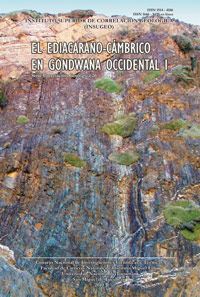Serie Correlación Geológica 26
Provenance of the Ediacaran-Early Palaeozoic Arroyo Del Soldado Group (Uruguay) and the Nama Group (Namibia): Geodynamic Implications for the SW-Gondwana amalgamation.
Descargar trabajo en formato PDFResumen
PROCEDENCIA DEL GRUPO ARROYO DEL SOLDADO (URUGUAY) Y EL GRUPO NAMA (NAMIBIA): IMPLICACIONES GEODINÁMICAS PARA EL SW DE LA AMALGAMACIÓN DEL GONDWANA.- Los resultados de petrografía, análisis de minerales pesados y geoquímica del Grupo Nama se caracterizan por una composición similar a la corteza continental superior reciclada con fuentes principalmente metamórficas-graníticas y con un componente máfico subordinado. Paleocorrientes de areniscas que contienen spinelos cromíferos pertenecientes a la Cuenca Nama indican una fuente localizada en el cinturón Damara. Edades U-Pb de circones detríticos del Grupo Nama muestran que los picos más importantes son Neoproterozoicos y Mesoproterozoicos y sugieren una proveniencia de los cinturones Damara-Gariep y sus basamentos. Paleocorrientes desde el oeste en los sedimentos molasicos de la Cuenca Nama y edades U-Pb en circones detríticos correspondientes al Neoproterozoico-Cambriano (76%) indican probablemente una fuente proveniente de una raíz de arco volcánico de composición félsica exhumada luego de la edad indicada por el circón mas joven que es de 531 ±9 Ma. La petrografía y los resultados geoquímicos del Grupo Arroyo del Soldado indican una composición comparable a la corteza continental superior reciclada y se caracteriza por una diversidad de fuentes granítico-gnéisica y rocas maficas metamórficas. En promedio isótopos de Nd presentan valores negativos de εNd y edades TDM similares a las encontradas en el Gondwana. Edades U-Pb en circones detríticos indican fuentes principalmente Palaeoproterozoicas (1.7-2.0-2.2 Ga) y subordinadamente Arqueanas (2.5-2.9-3.5 Ga). La escasez de circones detríticos Meso-Neoproterozoicos y paleocorrientes hacia el este indican que el Grupo Arroyo del Soldado fue alimentado con detritos del cratón del Río de la Plata favoreciendo un ambiente geotectónico de margen pasivo para su depositación. Deformación del Grupo Arroyo del Soldado ca. 530 Ma ocurrió luego de colisión tangencial con un terreno de afinidad Africana. Finalmente la evolución paleogeografica basada en el análisis de proveniencia de la Cuenca Nama y la Cuenca del Grupo Arroyo del Soldado sugiere que la amalgamación del los cratones Kalahari/Congo con el cratón del Río de la Plata y el terreno Cuchilla Dionisio Pelotas (Arachania) ocurrió probablemente por acrecíon tangencial relacionado a un componente de esfuerzos N-S en un periodo durante 530 a 495 Ma.
Abstract
PROVENANCE OF THE EDIACARAN-EARLY PALEOZOIC ARROYO DEL SOLADADO GROUP (URUGUAY) AND THE NAMA GROUP (NAMIBIA): GEODYNAMIC IMPLICATIONS FOR THE SW-GONDWANA AMALGAMATION.- The petrographic, heavy mineral analyses and geochemical results from the Nama Group indicate a recycled upper crust composition characterized mainly by metamorphic and granitic and minor mafic rocks sources. Paleocurrent analyses of the chromian spinel bearing sandstones of the Nama Basin point to a volcanic island arc source located in the Damara Belt. Detrital zircon dating of the Nama Group display major peaks of Neoproterozoic and Mesoproterozoic ages suggesting a provenance from the Damara/Gariep Belts and their basements. Paleocurrents from the west and the dominance of Neoproterozoic-Cambrian detrital U-Pb zircon ages (76%) in the “Molasse” stage of the foreland evolution probably indicate exhumation of the felsic volcanic arc root which probably occurred after the time indicated by the younger zircon dated at 531 ±9 Ma. The petrographic and geochemical results from the Arroyo del Soldado Group indicate a recycled upper crust composition characterized by source diversity composed of granite-gneissic and mafic-metamorphic rocks. On average, Nd isotopes account for negative εNd values and TDM ages in a range of variation found elsewhere within SW Gondwana. Detrital U-Pb zircon dating indicate sources dominated by Paleoproterozoic (1.7-2.0-2.2 Ga) and subordinate Archaean ages (2.5-2.9-3.5 Ga). The scarcity of Mesoproterozoic and Neoproterozoic zircons and paleocurrent directions towards the east indicate that the Arroyo del Soldado Group was fed by detritus from the Río de la Plata Craton favouring a passive margin tectonic setting for their deposition. Deformation of the Arroyo del Soldado Group took place ca. 530 Ma, after strike-slip collision with an African affinity terrane. Finally, based on the paleogeographic evaluation, the provenance of Nama foreland basin and the passive margin deposit of the Arroyo del Soldado basin suggest that continent-continent collision of the Kalahari/Congo Cratons with the Río de la Plata Craton and the Cuchilla Dionisio Pelotas Terrane (Arachania) most likely occurred due to strike-slip accretion related to a component of N–S shortening in the period between 530 and 495 Ma.






